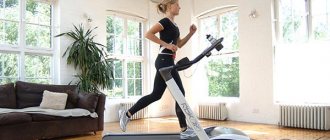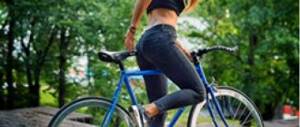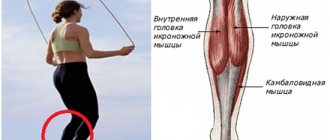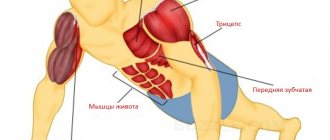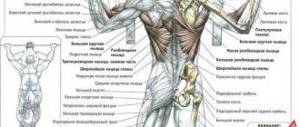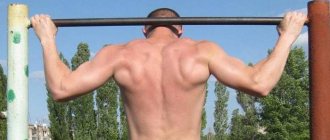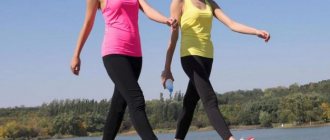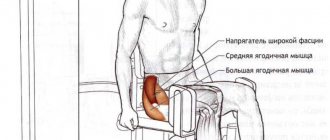Did you know that there is such a thing as “runner's high”? This is a feeling that can be compared to a mild degree of intoxication, characterized by a special uplift. Thanks to the “euphoria”, runners increase their resistance to fatigue and pain, due to the effect of cyclic load on the opiate receptors of the brain. Another significant bonus from running, but of course not the main one, because running:
- stimulates increased blood circulation;
- supplies brain cells with oxygen;
- promotes the development of the respiratory system;
- helps remove excess water and toxins from the body faster;
– increases the overall level of endurance of the body.
Not bad, right? But that is not all. Today we want to tell you what muscle groups are involved when you go for a run, and why a person who falls in love with running gets a strong, toned, sculpted body.
Muscles that work during running sessions
Let's list which muscles are involved when running, and then look at which of them work harder, depending on the type of running:
- Femoral - located on the back of the thighs, control the flexion and extension of the knees;
- Gluteal muscles - help keep the body in an upright position;
- Iliacs - it is thanks to them that the mobility of the legs is achieved;
- Quadriceps - located on the front surface of the thigh, thanks to them the leg works in a bend, the correct movement of the knee and hip joints is carried out;
- Intercostal - work during inhalation and exhalation of air;
- Calves - located in the lower leg, responsible for raising and lowering the leg to the surface of the earth;
- Lower and upper abs - control the position of the torso;
- Biceps - used when moving your arms. If you want to pump them up a little while running, wear small dumbbells;
So, we've explained in detail which muscles are affected by running, but now let's look at which ones work more intensely when climbing a mountain, jogging on a flat surface, or on a treadmill.
What works when jogging
Thanks to the measured pace, it is easy to cover very long distances in this mode - during them the calf and hip muscles become very tired. The load on the muscles of the respiratory organs and abdominal region increases. We suggest listing which leg muscles work while running outdoors:
- Gluteal;
- Rear biceps femoral surface;
- Femoral anterior quadriceps;
- Quadriceps;
- Calf;
- Tibial.
If you are interested, let's call the muscles that work most actively when running with the sprint technique - the pelvic and calf muscles. They bear the main load during intense runs at high speed.
What works when running up stairs?
If you are wondering what muscles are trained when running uphill, we will name the anterior muscles of the lower leg and back. When descending, the buttocks and thighs experience particular stress.
By the way, this exercise is high-intensity, so it is great for weight loss!
What muscles work on the treadmill?
The treadmill requires effort from all of the muscle groups listed above, and especially the thighs, glutes, and calves. The flexors and extensors of the toes, the muscles of the back, shoulders, abdominal cavity and the diaphragm also work.
Cardio on an empty stomach. Is running in the morning effective?
Very often in American films, in order to evoke respect for a character, television screens show how he or she, dressed in a tracksuit and putting headphones in his ears, runs sweating through the streets, parks or beaches. This means that he runs like this every morning. The hero, of course, is athletic and fit, not at all fat. And many, inspired by this example, also try to force themselves to run in the morning.
However, running in the morning is not for everyone. You don’t need to think that this is the only possible option to keep your body in shape and lose weight. There are no universal workouts that are unconditionally suitable for everyone. Taking into account the characteristics of each person, not only the type of exercise is selected, but also its frequency, intensity and weight used.
What are the benefits of cardio on an empty stomach? Because during intense training the body actively consumes energy. This energy is first taken from glycogen stores in the blood, and then from fat.
That is why it is recommended to run for at least half an hour, because only after this period of time fats begin to be consumed. And in order for the body to use its own fat reserves, it is necessary not to give it to it with food.
Most often, not many people can go for a run without having breakfast.
In these cases, there is no need to mock yourself; this type of cardio exercise is not suitable for everyone. Most often, it is recommended to use such running not constantly, but only for a while: for a maximum of 3 months.
Why do you need to run in the morning on an empty stomach?
- in the pre-competition period for athletes who need to reduce their fat percentage to a minimum;
- when weight and weight loss froze in one place;
- if it is impossible to isolate the muscles in other ways;
- to reduce muscle volume;
- in order to speed up metabolism.
What happens in the body when running on an empty stomach.
During the night, while no food enters the body, glycogen is depleted. Therefore, without breakfast in the morning, the body needs to find energy to run, and it uses up its own fat reserves. However, when the fat reserve is depleted, muscle tissue is used. Also, the body, which is not accustomed to this, will begin to make reserves at the next meal - and these are fats.
Therefore, if the goal is to burn fat, but leave muscle, it is better to eat food rich in protein before running, so that after depleting fat reserves, the body switches to protein from food, and not from muscles. If the goal is to burn muscles, making them smaller in volume, then after running it is better to eat food rich in carbohydrates. This way the body will not begin to store fats in reserve.
However, running in the morning on an empty stomach occurs when a person wants to start losing weight, but is not yet involved in serious sports. Running can be modified into brisk walking before breakfast. Such loads will already put the cardiovascular system in order, remove some of the excess fat and prepare the body for heavier loads.
Important!
Many people start running in the mornings in the spring to get their bodies in shape for summer. The fastest way is to run in the morning on an empty stomach. However, such training is not suitable for everyone.
It is also necessary to clearly know the purpose of this type of cardio exercise, and therefore adhere to certain rules.
However, if you follow all the recommendations, then running on an empty stomach will improve your existing form and prepare your body for future serious training.
running cardio weight loss workout
How to pump up your body with jogging
So, we looked at which muscle groups work when running up stairs, on the street and in the gym, and now let's talk about how to increase muscle mass. As mentioned above, it’s difficult to increase volume with jogging alone, but it’s easy to strengthen and improve quality. Remember and apply the following recommendations:
- Increase your driving speed regularly;
- Several times a week, do stressful exercises for yourself - interval running, sprinting technique, hill climbing;
- Use weights;
- Add strength training to your schedule;
- Follow a sports diet based on protein foods;
- Accustom yourself to general strengthening gymnastics: abdominal exercises, push-ups, running in place, jumping, squats, stretching.
Many people are interested in which muscle groups are affected by running in the evenings, but we argue that there is no particular difference in the distribution of load, depending on when the athlete trains. Morning, afternoon or evening, you run the same way, alternating the stages mentioned above, using the same muscles.
Running and gaining muscle mass
There is a lot of disagreement about the compatibility of strength and aerobic exercise. There are athletes who are of the opinion that it is simply impossible to do cardio without compromising strength training.
This theory has many opponents who believe that sports without cardio cease to be complete.
To dispel doubts regarding the inclusion of running in a bodybuilder’s training program, it is necessary to analyze the effect of aerobic exercise on the process of muscle growth.
During a training period aimed solely at gaining mass, it is, of course, not worth doing cardio every day.
Otherwise, excessive loads will lead to overtraining, which should be strictly avoided.
The effect of cardio on muscle gain
Scientific studies have proven the positive effect of running on muscle growth. Aerobic exercise stimulates protein production and increases testosterone, the main anabolic hormone. Cardio does not interfere, but, on the contrary, promotes muscle growth.
Running during the period of mass gain is useful because cardio:
- trains the heart muscle and has a positive effect on the cardiovascular system;
- improves endurance and helps diversify your training program;
- stimulates the burning of subcutaneous fat and makes the muscle relief more pronounced;
- accelerates metabolic processes, which leads to increased appetite, and, therefore, allows you to gain weight faster.
Aerobic exercise provides many benefits during weight gain. But, of course, only when certain rules are followed.
How to do cardio while gaining muscle mass
Experienced athletes recommend long runs at a slow pace to increase endurance and improve the condition of the heart muscle. You need to run for at least 40 minutes. Be sure to keep the pace slow.
Otherwise, there is every chance of starting to lose muscle mass. Only a few athletes practice short-distance sprints at maximum speed, most of whom do not engage in bodybuilding at a professional level.
Along with the duration and pace of running, the frequency of aerobic exercise is also crucial.
Attention!
During the period of muscle building, it is recommended to include cardio in the training program twice a week, doing low-intensity jogging for 40-60 minutes.
This kind of cardio speeds up your metabolism and improves endurance without compromising muscle building. When there is not enough time, you can reduce the amount of aerobic exercise to one workout per week, but increase the duration, running from 60 to 80 minutes.
Athletes involved in strength sports often neglect aerobic exercise, which negatively affects heart health. High-quality cardio training, performed at least once or twice a week to increase endurance and improve health, allows you to avoid adverse consequences.
Running and amateur bodybuilding
Strength training, aimed solely at maintaining good physical shape, and not for the purpose of performing at various bodybuilding competitions, must be supplemented with cardio.
Many owners of impressive weight, pumped up and sculpted muscles visit the gym solely for one single purpose - to look good with a beautiful body.
When pumping up muscles only at an amateur level, and not at a professional level, you should definitely run to be more resilient and fit, since cardio helps you lose excess subcutaneous fat.
How to jog correctly for weight loss
It is possible to lose excess weight by jogging. To do this, you need to know some principles.
The pace of jogging must be maintained at a measured pace. The shortest exercise time is an hour to an hour and a half, three times every seven days. Don't forget that the amount of calories burned should be greater than the amount of food consumed. If the diet and quality of food at one meal do not change before and after training, fat will be removed. To calculate energy expended, you need to know how many calories are burned while jogging. The average figure for this indicator is 100 Kcal in ten minutes.
What does jogging do in half an hour?
Most importantly, you get half an hour of pleasure. Jogging burns 300 kcal in 30 minutes. Charges with energy. Helps you relax, unwind, and relieve stress. Improves the nervous, cardiovascular and immune systems.
Buttocks
The largest muscle in the human body and, not unimportantly, the most attractive (the only rival in the female half is the pectoral muscles).
They include 3 gluteal muscle groups:
- small;
- average;
- big.
They begin to work to their full potential when the hip is retracted, that is, their work is associated with the hamstrings. The gluteal region is especially well worked out when running on a hill, when, upon contact with the surface, the load first falls on the quadriceps, and then the hamstrings and buttocks are included in the work.
Muscle groups involved in running
After reading the article, you will be convinced that running trains all major muscle groups, allows you to maintain and maintain shape and has a beneficial effect on the body as a whole.
While jogging, an athlete pumps not only the muscles of the musculoskeletal system, but also the heart muscle. Running is known as one of the best forms of cardio exercise. One can note the health-improving effect of this sport on almost all components of the body and internal processes of the body.
Positive effects of running:
- Removes toxins and excess water from the body;
- Reduces fat deposits;
- Promotes body hardening;
- Stimulates hematopoiesis - the formation of new “young” blood cells;
- Has a beneficial effect on the respiratory system.
Not everyone knows that while running, endorphins are produced, known as “happy hormones.” Brain activity also improves as a result of stimulation of blood circulation, because it is the blood that provides nutrition to the brain and its saturation with oxygen.
Synchronized muscle work is the key to positive results!
Important! Muscles work together, and the action of one group complements the work of the other. Even with minor deviations, the efficiency of movements is reduced to a minimum level. And if you jerk your leg at the wrong moment, performing the appropriate phase of running exercises becomes impossible.
The effort of single muscles will not be enough to move the body. The human body is a complex mechanism, and one of the main roles in it is assigned to the brain. It is he who is responsible for motor activity, and a person only determines what he wants. And the brain acts as a “general”, giving orders, as a result of which the functions of various muscles are activated or blocked. It is thanks to such a complex mechanism that our body can move. Muscles must work together, and this is what allows us to walk and run without any difficulty.
Useful tips
Today, running training can be carried out outdoors, in specialized fitness centers, stadiums, or at home on a treadmill. Regardless of the location of your jogging, in order to work out your muscles well, you must follow a number of rules:
- It is recommended to run only in special sneakers, which will prevent injuries to the knee and joints;
- Before jogging, it is mandatory to warm up for 10 minutes in the form of stretching, bending to the side and leisurely walking, which will warm up the muscles and increase blood circulation;
- to work the soleus and buttock muscles, it is recommended to learn how to run with the foot lowered to the front;
- it is necessary to alternate days of rest and running, while for non-professional athletes the optimal number of runs is considered to be no more than 3 times a week;
- if you want to stop running, it is recommended to gradually reduce your speed;
- after 1.5 to 4 hours, massage treatments can be performed for relaxation purposes.
It is worth remembering that sports training should be enjoyable, so you should not bring your body to complete exhaustion.
Does muscle burn?
We looked at what muscles develop when running and told us how to pump them up a little. However, there is an opinion that running can burn muscle mass - not fat, but a beautiful relief that is built with such difficulty. In fact, such a problem really exists and it concerns all bodybuilders on our planet - how to get rid of fat, but not muscle volume. If you go on a low-calorie diet and at the same time actively run, you will lose weight, but we are not happy with this result.
